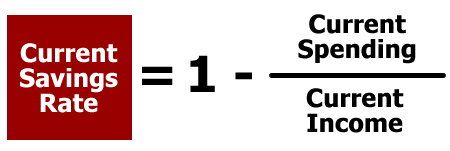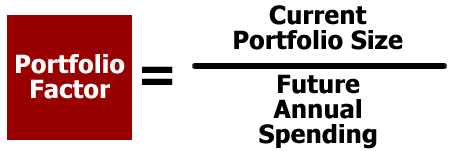For a while now, I’ve been thinking about a better way to publicly track my progress towards financial freedom and also allow easier comparisons between readers. I’m sure some people would miss the net worth updates, but I have reached the point where our net worth fluctuates mainly with stock market valuations and not due to actual improvements to income or savings rates.
First, I started to brainstorm the required data needed for such tracking, each of which I can address in a future post. Once we collect these numbers, I can then put out some numbers and ratios that could be better indicators than plain net worth. Heck, a portfolio of a million dollars is nothing if you plan on spending $100k a year, but if you only spend $40k a year and have a small pension, you could be all set.
- Current Monthly Income (After-Tax)
How much money are you taking in right now? For those with variable paychecks, it would probably be best to average this out over the trailing 12-months or 6-months. - Current Monthly Spending Rate
How much are you spending? This should also be averaged out over at least 6 months, in order to capture all those irregular bills like my semi-annual car insurance bill, as well as those unexpected expenses that always pop up. For example, in the last few months alone we have had an $1,000 electrician bill and a $500 auto repair tab. - Current Portfolio Size
How big is your current investment nest egg? If you include your house, then you’ll need to include the cost of renting in your future spending. - Future Spending Rate
What is your “burn rate” going to be in retirement or semi-retirement? Many online calculators simply assume this is 85% to 100% of your current monthly spending. This can be too generic. For example, in less than 20 years, I plan to have my house paid off. My mortgage is more than 50% of my current expenses! Other items like health insurance premiums will be harder to predict. - Investment Return
There are many smart folks making educated guesses about future market returns based on both looking backwards and forward. Based on your chosen asset allocation, one can at least attempt a rough estimate of future after-inflation returns. We can’t rely on these numbers, but it’s a good beginning. - Safe Withdrawal Rate / Retirement Income Rate
How will you create your income during retirement? If it’s going to be from selling stocks or bonds, you’ll have to decide on how much is okay to withdraw each year so that you don’t run out. Will you draw a fixed percentage each year? Adjust annually for inflation? Adjust annually for market returns?What if you are planning to live off dividends or bond income? What if these fluctuate? If you have a pension or annuity, how will this fixed income change how you draw down other assets?
Potential Indicators
A simple example would be calculating your personal savings rate, which would be independent of market fluctuations for most people:

Multiply by 100 for a percentage. Hopefully this isn’t negative! Another good ratio might be your portfolio multiplier factor, which tracks how big your portfolio is relative to your planned future spending.

Depending on who you talk to, a Portfolio Size Factor of 25 to 35 might be desirable if you are withdrawing money from a portfolio of 60% stocks and 40% bonds. Adjustments should be made for pre-tax vs. post-tax accounts.
I could post these and other monthly indicators each month, instead of net worth. What do you think? Any other numbers that I’m missing?
 The Best Credit Card Bonus Offers – 2025
The Best Credit Card Bonus Offers – 2025 Big List of Free Stocks from Brokerage Apps
Big List of Free Stocks from Brokerage Apps Best Interest Rates on Cash - 2025
Best Interest Rates on Cash - 2025 Free Credit Scores x 3 + Free Credit Monitoring
Free Credit Scores x 3 + Free Credit Monitoring Best No Fee 0% APR Balance Transfer Offers
Best No Fee 0% APR Balance Transfer Offers Little-Known Cellular Data Plans That Can Save Big Money
Little-Known Cellular Data Plans That Can Save Big Money How To Haggle Your Cable or Direct TV Bill
How To Haggle Your Cable or Direct TV Bill Big List of Free Consumer Data Reports (Credit, Rent, Work)
Big List of Free Consumer Data Reports (Credit, Rent, Work)
Metrics can be real powerful when used properly. I still think networth is something to consider, but only as a part of the picture, not the whole thing. I think you need a “portfolio” of metrics similar to what you are proposing to do this right.
I also wrote a post on this: http://notrichyet.com/?p=37
I believe that the reciprocal of the “Portfolio Factor” is also useful as well. It would give you the interest rate (or annual yield) that you would require from your investment portfolio to live off the interest in perpetuity.
~Dan
I think that’s a great idea!
I think you need to report the numbers separately and as ratios. Otherwise there is too much room for manipulation. For example, your portfolio factor would improve if you reduced your GUESS at future spending.
My approach is:
1. ASSUME future spending rate
2. Calculate the target portfolio size, with a fixed spending ratio (25).
3. Calculated what my monthly savings would need to be for a range of investment returns (0% to 10%) and target ages (50 to 75).
That way, I could easily look at what it would take (combination of saving rate and investment returns) to acheive optimistic, likely and pessimistic retirement dates.
Putting all of this in a spreadsheet, I could update it as needed (e.g. increase assumed spending).
As time went on, my portfolio grew, and my savings rate became less and less important (but investment return became critical).
Putting all this together, my indicator became “Financial Independence Day”, the date I could stop working if I wanted to, based on a conservative set of assumptions (investment return of 4%, savings rate of 10%)). If this date was getting closer, I was succeeding and if not, I could correct it by saving more.
This date can fluctuate as the markets fluctuate, so it’s a good reality check if your portfolio is too volatile. (In January 2009, it looked like I had to work an extra 15 years!)
I’ll tinker around with these formulas, but they seem overly complicated. While you have a target for the second indicator, you did not list a target goal for current savings rate (other than to say it should not be negative). I tend to stick to simple rules when it comes to money:
Net worth = Age X pre-tax income/10
(My yearly goal is to get our actual net worth as close to this figure as possible)
Retirement investments = 10 – 30% of salary
(We keep this somewhere in the middle, but I recently discovered that we should not be investing in a 529 plan until we are saving as much as possible for retirement)
Asset allocation: % Stocks = 120 – Age
(I include stock mutual funds in this)
Emergency fund = 6-8 (mos) X take home pay
(Almost there)
Burn rate in the future is unpredictable, so we simply save and invest till it hurts.
Ron, question for you am I reading your comment right that you do 6 to 8 times take home pay for your emergency fund? That seems awful steep compared to the 6-12 months of living expenses others suggest. But maybe I read your comment wrong.
I think whatever you decide, at least a period of combined net worth and other stats would be useful to get an intuition of how they compare.
The portfolio factor is good, but won’t this track with your net worth? How will this be a “new” indicator (rather than a new way of looking at the old one)?
I like the savings rate, since it keeps the pressure on, regardless of how much one has in net worth. However, what does one include in the income and savings categories in order to not make them skewed. For example, do you count debt payment (student loans, other loans, mortgage) as spending or do you count the initial loan purchase as the spend?
Ron et al,
Here’s a controversial thought: Why save anything towards retirement if you have reached your net worth target? (Surely that target implies that you have “enough”?)
I know you said future burn rate is unpredictable so save till it hurts. I disagree -I think your goal should be to have the same lifestyle in retirement as you have now – possibly slightly better but definitely not worse. I believe that will maximize your lifetime happiness. Steps down are painful, and rapid steps up are not as satisfying as gradual ones.
@sanders
he is saying 6 to 8 months of take home pay. for most people, take home pay isn’t too far from living expenses… did you think he meant 8 to 8 years?
Although your house will be paid off- your property taxes and insurance will continue to go up. So will repairs. Currently, those expenses are about 1/4 of our retirement expense. Our largest regret is not looking seriously at these expenses before we bought.
Nate has it right. Not too long ago, the rule of thumb was to build up 3 months take home pay in the event of unforeseeable contingencies. That’s just not enough anymore.
I agree with Sanders, 6 – 8 times is awful steep. In fact, I think it sucks that we have to save so much. I’m still really pissed at Lehman Bros., Madoff, AIG, and those rogue mortgage lenders for bringing us to this point. The good thing is, once we’ve reach our target, the cash that we’ve been so used to squirreling away will be reallocated into increasing our retirement/Roth contributions.
@ Mark, we are far from our net worth goal, I’m ashamed to say. I didn’t mean to lead anyone to believe that we had already reached it. Also, we’ve grown accustomed to living with less. With the way the world is right now, my wife and I do not mind taking those lifestyle downgrades like foregoing those expensive evenings at fine restaurants or avoiding haphazardly swiping our credit cards on far away vacation trips. We’ve already taken “steps down” in order to save more. It really hasn’t been that painful since there are so many ways to enjoy life without spending so much. CNBC has a great show out of Canada called Till Debt Do U$ Part:
http://www.cnbc.com/id/33421145/
Although my wife and I have virtually no debt, we love the way that lady makes those debt-ridden couples spend only mere pennies to go out and have a good time.